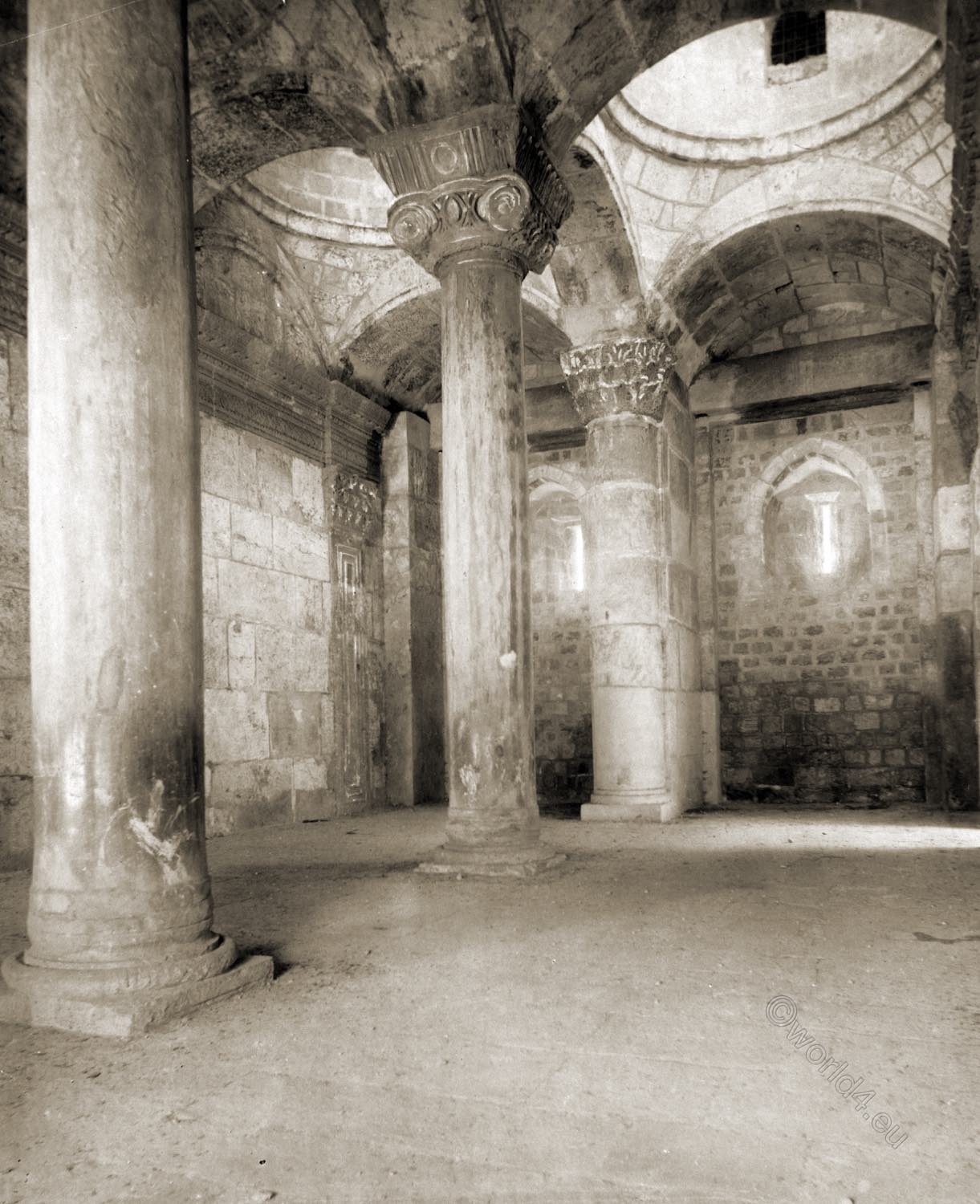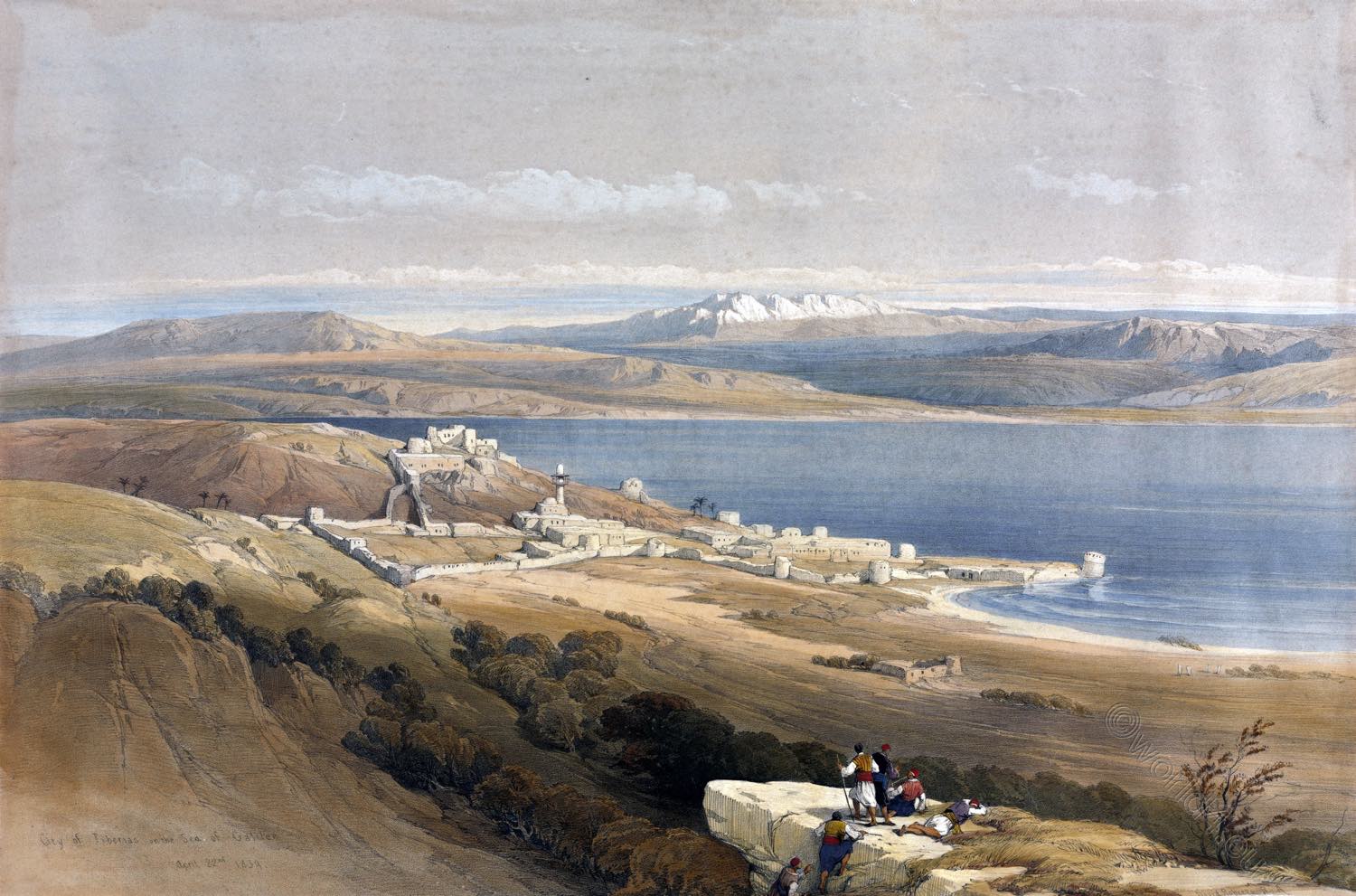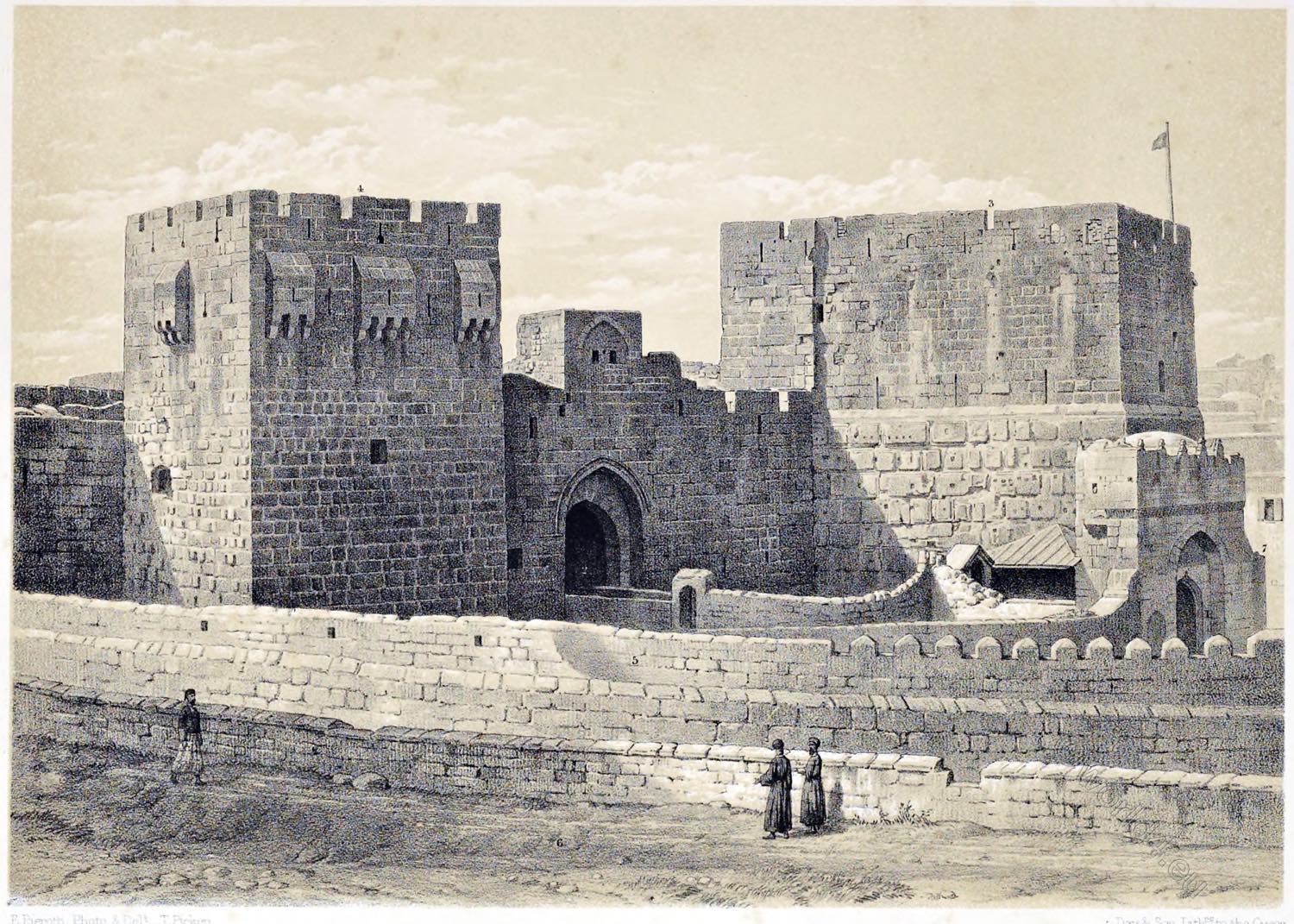
EASTERN VIEW OF THE GOLDEN GATE.
by Ermete Pierotti
PLATE XVIII.
- Stones of the time of Solomon.
- Wall of the time of Sulyman.
- Wall of the time of Justinian.
- Golden Gate, closed with a native Wall.
- Modern Mohammedan Tombs.
- Inclination of Mount Moriah.

Western view of the Golden Gate at Jerusalem.
PLATE XIX.
by Ermete Pierotti
- Wall of the time of Justinian.
- Ornaments of Justinian.
- Native House.
- Modern native Construction.
- Haram es-Sherîf

THE GOLDEN GATE.
by David Roberts
This is a massive structure, a double gateway, projecting from the eastern wall into the area of the Harem-esh-Sherif (the Noble Sanctuary), in which stands the Great Mosque. Its floor is several feet below the level of the area.
After the second revolt and total ruin of the Jewish people, Hadrian (a.d. 136) built a new city, which he called AElia; and, for the purpose of offering the last insult to an unhappy nation, he raised a temple to Jupiter on the site of the Temple of Solomon.
The style of the Golden Gate appears to refer it to this period; the external front and arches are unquestionably of Roman origin; and of the interior it is evident, that “a central row of noble Corinthian columns and a groined roof, had once formed a stately portico of Roman workmanship.”1


The name “Porta Aurea” cannot be followed higher than the tenth century. This gate was found walled up in the time of the Crusades, but was then opened once a-year, on Palm Sunday, from a tradition that through it our Lord made his entry into Jerusalem as king; a tradition probably arising from the stateliness of its architecture.
By the Moslem, however, it is kept constantly walled up from a singular dread, that through it a king shall enter, who is to make himself master not only of Jerusalem, but of the globe. And that their vigilance, at least, may not be wanting to avert the conquest, they keep a sentinel constantly on duty in a tower flanking the gateway.2

1) Bononi and Catherwood, referred to by Robinson, Biblical Researches, vol. i. p. 438. 2) Stephens, p. 94.


THE INTERIOR OF THE GOLDEN GATE. JERUSALEM.
by Thomas Hartwell Horne.
Drawn by D. Roberts, from a Sketch made on the spot by F. Catherwood, Esq.
The Bab-el-Darahie, or Golden Gate, on the eastern side of Jerusalem, is supposed to have derived its name from the splendor of its gilding, which distinguished it from all the other gates of that city. It has long been walled up by the Turks, who have a traditional prediction, that the Christians will one day enter through this gate, and capture Jerusalem. An ancient tradition states, that Jesus Christ made his triumphal entry into the city through this gate, five days before the passover; when “much people … took branches of palm trees, and went forth to meet him, and cried, ‘Hosannah! Blessed is the King of Israel, that cometh in the name of the Lord.’ ” (John, xix. 12, 13.)
Our view represents the interior of this gateway: it is entered from the inclosure of the Mosque of Omar, and exhibits remains of buildings far more ancient than that mosque, which is in the Saracenic style of architecture, while the capitals of the columns are evidently of a debased composite order. There is, indeed, very great probability for concluding that the Golden Gateway is a construction of King Herod on his rebuilding the second temple at Jerusalem; the whole of which may have been erected in the same depraved style of Roman architecture. Although the taste displayed in this gateway is bad, yet its general proportions are good; and its solidity (the walls being ten feet thick) has preserved it from destruction.
Each column is composed of a single block of marble, of a kind which is not now found in the vicinity of Jerusalem. They may, perhaps, have formed part of the second temple as restored by Herod; unless, indeed, they were erected by the emperor Hadrian, to adorn the city AElia Capitolina, which (it is known) he built on the site of the ruins of Jerusalem.
There is another gateway under the mosque al-Aqsa of the same period, and of equally solid construction: this latter gateway is also walled up. There has been a noble flight of steps from the Golden Gate leading directly to the Temple; the difference of level being very considerable, not less than twenty-five or thirty feet, in the judgment of the ingenious artist who executed the original sketch of the Golden Gate whence our view is engraved, and who was the first European that ever examined these two gateways.
Manuscript communication from F. Catherwood, Esq., from whose sketches a very interesting Panorama of Jerusalem has been painted.
Source:
- The Holy Land, Syria, Idumea, Arabia, Egypt, & Nubia, by David Roberts, George Croly, William Brockedon. London: Lithographed, printed and published by Day & Son, lithographers to the Queen. Cate Street, Lincoln’s Inn Fields, 1855.
- Intérieur de la porte dorée Interior of the golden gate. Maison Bonfils (Beirut, Lebanon), photographer. Source.
- Jerusalem (El-Kouds). Golden Gate from the east. American Colony (Jerusalem). Photo Department, photographer. Source
- Around the city wall [Jerusalem]. The east wall, showing Herodian wall and Golden Gate. American Colony (Jerusalem). Photo Department, photographer. Source.
- Jerusalem Explored. Being a description of the ancient and modern city, with numerous illustrations consisting of views, ground plans, and sections by Ermete Pierotti; translated by Thomas George Bonney (Fellow of St Johns College, Cambridge). London: Bell and Daldy; Cambridge: Deighton, Bell and Co. 1864.
- The City of the great king and other places in the Holy Land. Pictured by Dean Cornwell and described by William Lyon Phelps. Society of the Four Arts King Library, 1926
- Landscape Illustrations of the Bible, consisting of views of the most remarkable places mentioned in the Old and New Testaments, from original sketches taken on the spot by Thomas Hartwell Horne (Autor, 1780-1862), engraved by William Finden (1787-1852), Edward Francis Finden (1791-1857), Joseph Mallord William Turner (1775-1851), Bartolomé de las Casas (1474-1566). London: John Murray: Sold also by Charles Tilt, 1836.
Continuing






